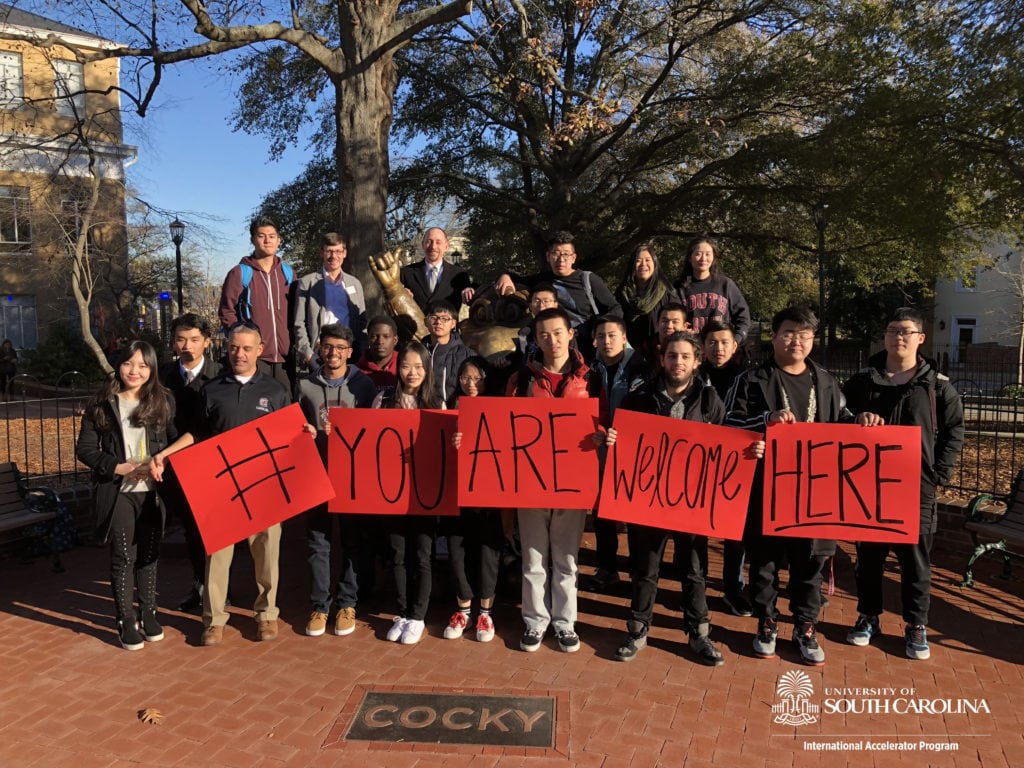U.S. Universities to International Students: #YouAreWelcomeHere
Imagine walking onto a U.S. campus to a group of students cheering your arrival. That’s the kind of friendly, supportive message universities across the U.S. are sending through social media posts, local events and the compelling videos at the center of the #YouAreWelcomeHere campaign.
The campaign set out in late 2016 to reassure international students that they are welcome in the United States following President Donald Trump’s travel banand that it is safe to study in the U.S.
Since then, students, faculty, and community members of more than 300 universities have posted signs and made videos encouraging international students to come and study at their schools. More than 55 schools are also offering two annual, renewable scholarships to undergraduate international students dedicated to bridging cultural divides.
“They help us achieve and grow in meaningful ways,” says JoAnne Epps, provost of Temple University, of international students in the school’s #YouAreWelcomeHere video.
#YouAreWelcomeHere is one of many ways U.S. universities welcome international students to campus despite the U.S. travel ban. Here are 4 other ways:
1. Airport Pickup and a Friendly Welcome
“The minute international students arrive, we want them to see a friendly face,” says Todd Ellwein, managing director of Louisiana State University’s global program. International students are greeted at the airport by university staff, students, or community members. Often, their new dorm rooms are decorated with welcome cards and stocked with snacks. These small efforts go a long way, Ellwein says.
2. Orientation and Mentoring Programs to Help Students Get Settled
Orientation week is a multi-day program on U.S. campuses that introduces international students to campus life and the surrounding community. The orientation staff at U.S. universities help students:
• Choose a meal plan
• Set up a bank account
• Learn where they can buy their favorite foods
• Find out about class schedules and locations
• Get answers to other basic questions
Mentoring programs help international students meet with U.S. students by matching them with a U.S. peer.
Schools call these programs by different names, for example, Peer2Peer, Buddies Beyond Borders, and Student Ambassadors. But all give international students someone to turn to and get answers to questions, such as how to get around town and what Instagram accounts share tips about city nightlife.
3. Ongoing Support Covering Visa Issues, Internship Opportunities, and Community Matters
International students should know that someone is always here for them, says Julie Medlin, international program coordinator at the University of South Carolina. Most universities send frequent newsletters or emails with updates covering everything from final exam dates to how to avoid visa issues to student employment and internship opportunities.
An update on the U.S. travel ban is a permanent link on the International Program’s home page at the University of Kansas.
Many universities also use social media to stay in touch, but importantly, students can talk in person with someone in the international student office. “Being able to drop in a have face time with staff can be comforting when you’re far from home,” says Medlin.
International student welfare is so important that two years ago, Temple University created a position dedicated solely to supporting international student life.
“We were bringing students here but wanted to do a better job of helping them, so my role was added,” says Leah Hetzell, who oversees international student affairs at Temple University. Homesickness and culture shock can be a part of studying abroad, she says, and a lot of schools recognize that they can better respond to students’ needs.
4. Promoting a Campus-wide Embrace of International Students
One positive outcome of the U.S. travel ban and the #YouAreWelcomeHere campaign has been an increase in support for international students on campuses across the country. During the uncertainties stemming from the travel ban, one department at the University of South Carolina reached out to the international office, worried about the ban’s effect on students from other countries.
Members of Grinnell College’s student government began actively looking for ways to better support international students. “It’s helped make staff, faculty, and students stronger advocates for international students,” says Karen Edwards, director of International Student Affairs at the private liberal arts school in Iowa.
Some universities are also exploring ways to increase the profiles of international students on campus. People walking around Eastern Michigan University see banners on light posts featuring 108 of the school’s international students, with #YouAreWelcomeHere in bold type.
Students at the University of Kansas might notice more stories about their international peers in the school paper and on social media. “Increased visibility can help international students feel more appreciated and involved,” says Charlie Bankart, Kansas’ associate vice provost of international students.
Julie Medlin at the University of South Carolina points to the school’s Think Globally program as a means of student integration and dialogue. Universities have held international days and festivals for years, but students are facilitating stronger discussions among themselves. In one session, U.S. students asked Chinese students whether women in China bind their feet and how Muslim women feel about wearing hijabs (head coverings). These kinds of frank conversations break down stereotypes and misconceptions, says Medlin.
She adds that when international students feel like they’re part of the campus community. When they have a voice, they feel welcome.
Want to learn more about studying in the U.S.? Explore international-friendly universities or connect with a counselor.
